 |
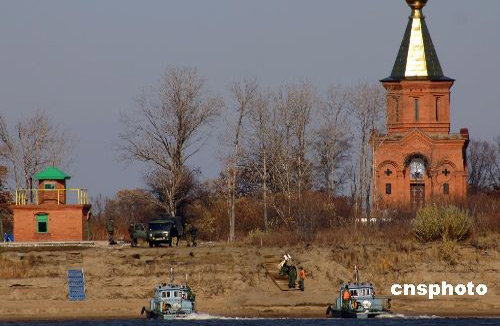 -
1
China and Russia prepare for the launching ceremony of the border monument on Heixiazi Island/Bolshoy Ussuriysky Island, October 13, 2008. The ceremony, held a day later, marked Russia transferring half of the island’s sovereignty to China. This ended the boundary demarcation work between China and Russia, for which the two countries had negotiated for more than 40 years. The island had been occupied since 1929 by the Soviet Union during a border skirmish.[Chinanews]
-
Return of Heixiazi Island/Bolshoy Ussuriysky Island
On October 14, 2008, China and Russia held a ceremony to unveil a stone monument on Heixiazi Island. The western part of Heixiazi Island was returned to China, demarcating the northeastern tip of the 4,300-km Sino-Russian border.
According to the Complementary Agreement between the People's Republic of China and the Russian Federation on the Eastern Section of the China-Russia Boundary signed on October 14, 2004, Heixiazi Island was divided into two parts. The western part belonged to China and it would become "the first place on the Chinese mainland to see sunlight."
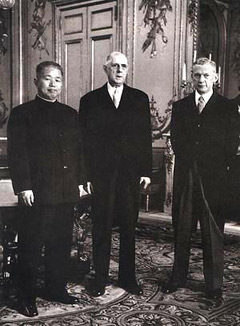 -
2
On January 27, 1964, China and France established diplomatic relations at ambassadorial level. This picture shows Huang Zhen (1909-1989) (left), the first ambassador of the People's Republic of China to France, together with Charles de Gaulle, the then French president.
-
Establishment of Sino-French relations
On January 27, 1964, the Chinese and French governments issued a joint communiqué announcing the establishment of Sino-French diplomatic ties, with ambassadors to be appointed within three months.
Authorized by General de Gaulle, former French Premier Edgar Faure visited China in October 1963, carrying with him a hand-written letter from the general on whose behalf he would discuss Sino-French relations with the Chinese leaders.
China adopted a flexible attitude toward the specific steps to be taken in establishing the diplomatic relations while maintaining its principled position of opposing the creation of "two Chinas". After China and France reached a tacit agreement on France recognizing the government of the People's Republic of China as the sole legal government of China, China accepted the French proposal: to announce the establishment of Sino-French diplomatic relations first, thus leading to the severance of diplomatic relations between France and Taiwan.
Pursuant to the prior agreement between the two countries, a spokesman of the Chinese Foreign Ministry was authorized to issue a statement on January 28 concerning the establishment of the diplomatic relations, pointing out that the sole legal government of the People's Republic of China had held negotiations and reached an agreement with the Government of the French Republic on the establishment of diplomatic relations between the two countries. This was a major breakthrough in China's efforts to strengthen its relations with Western Europe.
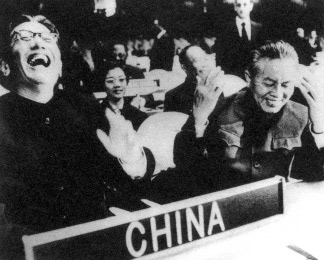 -
3
The passage of Resolution 2758 at the 26th Session of the United Nations General Assembly on October 25, 1971 restored the People's Republic of China's lawful rights to the UN. Upon hearing that China had regained its seat in the UN, Foreign Minister Qiao Guanhua couldn't contain his excitement.
-
China's resumption of legal seating in the United Nations (UN)
On October 25, 1971, the 26th United Nations General Assembly passed Resolution 2758 with an overwhelming majority of votes and restored all the lawful rights of the People's Republic of China in the UN and expelled the representatives of the Taiwan authorities from the United Nations and all its affiliated agencies.
China had established diplomatic relations with only 64 nations prior to October 24, 1971, but after the passage of UN Resolution 2758, China's diplomatic stage soon extended far and wide globally. Currently, the number of nations that have diplomatic ties with China has reached 169, with more than 100 of them having established their diplomatic relations after China's reinstatement into the UN.
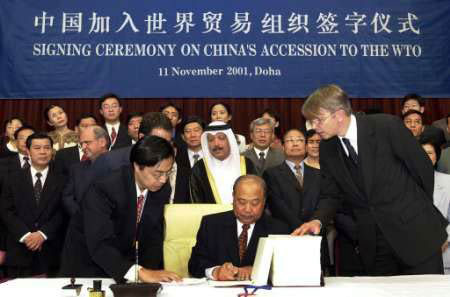 -
4
Shi Guangsheng, Chinese minister of foreign trade and economic cooperation, signs an agreement in Doha, Qatar, for China's accession to the World Trade Organization on November 11, 2001.
-
China's accession to the World Trade Organization (WTO)
After 13 years of painstaking negotiations, China successfully joined the WTO in November 2001. China's entry into the WTO has played a positive role in promoting the country's foreign trade and economic cooperation.
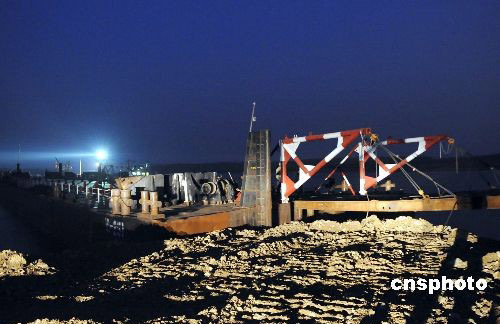 -
5
Chinese workers extend a floating bridge from the No.7 border monument standing in Fuyuan County, Heilongjiang Province, to Heixiazi Island on the night of October 13, 2008, just hours before Russia transferred half of the island's sovereignty to China. [Chinanews]
-
Return of Heixiazi Island/Bolshoy Ussuriysky Island
On October 14, 2008, China and Russia held a ceremony to unveil a stone monument on Heixiazi Island. The western part of Heixiazi Island was returned to China, demarcating the northeastern tip of the 4,300-km Sino-Russian border.
According to the Complementary Agreement between the People's Republic of China and the Russian Federation on the Eastern Section of the China-Russia Boundary signed on October 14, 2004, Heixiazi Island was divided into two parts. The western part belonged to China and it would become "the first place on the Chinese mainland to see sunlight."
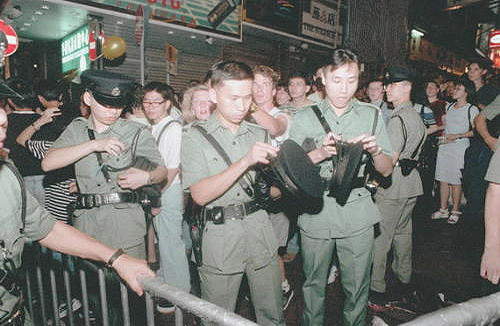 -
6
Hong Kong police change into their new uniforms in the middle of the night on June 30, 1997. The uniforms are decorated with the city's emblem, the bauhinia flower.
-
'One country, two systems' and the return of Hong Kong and Macao
In order to solve the Hong Kong issue, the Macao issue and the Taiwan issue, Chinese leaders put forward the concept of "One country, two systems" in 1982, paving the way for the successful return of Hong Kong and Macao.
In 1984, China and the U.K. finally signed the Sino-UK Joint Declaration after hard negotiations, culminating in the agreement to return Hong Kong to China. Under the "One country, two systems" policy, the Hong Kong Special Administrative Region was established in 1997, marking the first time the policy was put into practice.
Then, in 1987, China and Portugal signed the Sino-Portuguese Joint Declaration, with Portugal agreeing to return Macao to China in 1999.
Both Hong Kong and Macao have since maintained prosperity and stability.
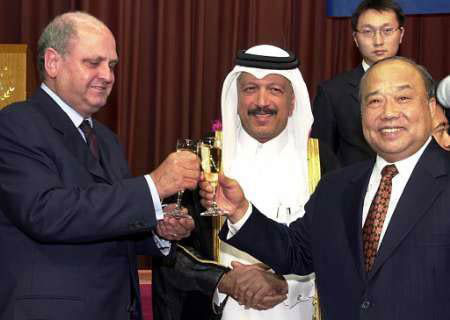 -
7
Mike Moore (first left), the director-general of the World Trade Organization, toasts China's accession to the WTO on November 11, 2001.
-
China's accession to the World Trade Organization (WTO)
After 13 years of painstaking negotiations, China successfully joined the WTO in November 2001. China's entry into the WTO has played a positive role in promoting the country's foreign trade and economic cooperation.
 -
8
Chinese Premier Zhou Enlai greets the crowd upon his arrival at the Geneva Conference on April 24, 1954. At the conference, Zhou proposed the peaceful unification of Korea as well as the restoration of peace to the Indochinese Peninsula.
-
Geneva Conference
In 1954, China attended the Geneva Conference as one of the Big Five for the first time and played a positive role.
The conference shattered the US prospect of isolating China from the world's diplomatic platform and enabled the diplomacy of the newly established People's Republic of China to successfully win the world's attention for the first time.
The Chinese delegation held more than 20 press conferences and accepted visiting foreign correspondents over 400 times during the conference.
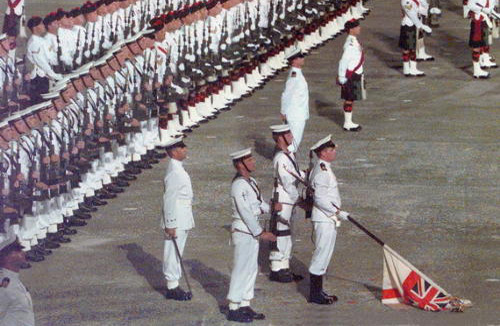 -
9
British troops parade on Hong Kong's waterfront for the "Sunset Farewell Ceremony" on June 30, 1997.
-
'One country, two systems' and the return of Hong Kong and Macao
In order to solve the Hong Kong issue, the Macao issue and the Taiwan issue, Chinese leaders put forward the concept of "One country, two systems" in 1982, paving the way for the successful return of Hong Kong and Macao.
In 1984, China and the U.K. finally signed the Sino-UK Joint Declaration after hard negotiations, culminating in the agreement to return Hong Kong to China. Under the "One country, two systems" policy, the Hong Kong Special Administrative Region was established in 1997, marking the first time the policy was put into practice.
Then, in 1987, China and Portugal signed the Sino-Portuguese Joint Declaration, with Portugal agreeing to return Macao to China in 1999.
Both Hong Kong and Macao have since maintained prosperity and stability.
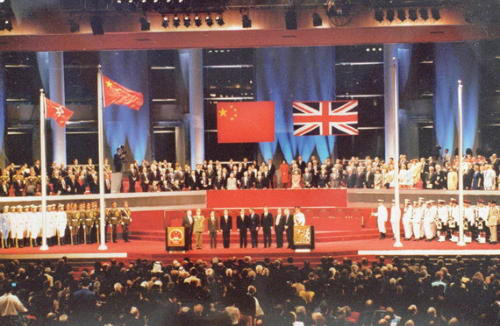 -
10
The transfer of sovereignty of Hong Kong, a former British colony, to the People's Republic of China. The ceremony, known as the Handover, was held at the Hong Kong Convention and Exhibition Center, from the night of June 30 to the dawn of July 1, 1997.
-
'One country, two systems' and the return of Hong Kong and Macao
In order to solve the Hong Kong issue, the Macao issue and the Taiwan issue, Chinese leaders put forward the concept of "One country, two systems" in 1982, paving the way for the successful return of Hong Kong and Macao.
In 1984, China and the U.K. finally signed the Sino-UK Joint Declaration after hard negotiations, culminating in the agreement to return Hong Kong to China. Under the "One country, two systems" policy, the Hong Kong Special Administrative Region was established in 1997, marking the first time the policy was put into practice.
Then, in 1987, China and Portugal signed the Sino-Portuguese Joint Declaration, with Portugal agreeing to return Macao to China in 1999.
Both Hong Kong and Macao have since maintained prosperity and stability.
 -
11
Nursultan Nazarbayev (middle), Kazakh president, receives the delegates of the Shanghai Cooperation Organization, which was founded by China, Kazakhstan, Kyrgyzstan, Russia, Tajikistan and Uzbekistan in 2001. This was the first meeting among leaders from the member countries and was held on September 14, 2001, in Almaty, Kazakhstan. [Xinhua]
-
The Shanghai Cooperation Organization (SCO)
The prime ministers of the SCO member states held their first meeting in Almaty in September 2001, announcing the intent to formally establish a regular meeting mechanism within the SCO framework.
In June 2002, the SCO members held the second summit meeting in St. Petersburg, and the government heads of the member states signed the Charter for the Shanghai Cooperation Organization, marking its establishment according to the international law.
The SCO was the first international organization to be established within Chinese territory and named after a Chinese city.
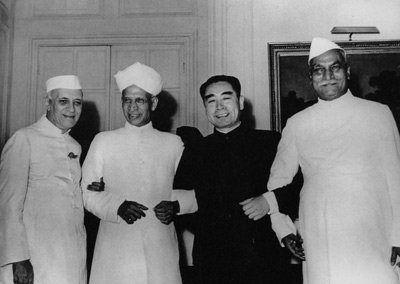 -
12
Chinese Premier Zhou Enlai (second right) visited India in June 1954. Also pictured were: Indian President Rajendra Prasad (first right), Deputy President Sarvepalli Radhakrishnan (third right), and Prime Minister Jawaharlal Nehru (far left). Zhou had previously proposed the Five Principles of Peaceful Coexistence to India in December 1953. [people.com]
-
Five Principles of Peaceful Coexistence
At the end of December 1953, in a meeting with a delegation from the Indian government, Premier Zhou Enlai proposed for the first time the Five Principles of Peaceful Coexistence: mutual respect for each other's sovereignty and territorial integrity, mutual non-aggression, non-interference in each other's internal affairs, equality and mutual benefit, and peaceful coexistence.
On April 29, 1954, China and India issued a joint statement and signed the "Agreement Between the People's Republic of China and the Republic of India on Trade and Intercourse Between the Tibet Region of China and India," recognizing the incorporation of the Five Principles of Peaceful Coexistence into the agreement as the norms guiding the relations between the two countries.
At the end of June 1954, Premier Zhou Enlai visited India and Burma, and the ensuing joint statements he issued with Indian Prime Minister Jawaharlal Nehru and Burmese Prime Minister U Nu also incorporated the Five Principles, further affirming that they were the norms governing international relations.
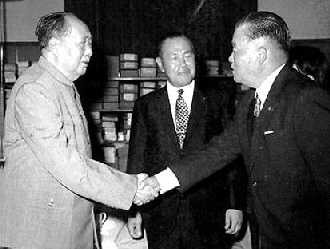 -
13
Chairman Mao Zedong meets with visiting Japanese Prime Minister Kakuei Tanaka (middle) and Foreign Minister Masayoshi Ohira on September 27, 1972. The two countries officially established diplomatic relations when the two governments issued Sino-Japanese Joint Statement on September 29 that year.
-
Normalization of Sino-Japanese relations
Japanese Prime Minister Kakuei Tanaka paid a visit to China from September 25 to September 30, 1972, as the guest of Premier Zhou Enlai. Chairman Mao Zedong also met with Prime Minister Tanaka and they had an earnest and friendly conversation.
The talks held in a friendly atmosphere between the prime ministers and foreign ministers of the two nations achieved great success. On September 29, Chinese and Japanese governments issued the Sino-Japanese Joint Statement, calling for an end to the abnormal state of affairs existing between the two countries and formally establishing diplomatic relations.
In addition, on November 9 of the same year, the Japanese lower house passed a bill to support the Sino-Japanese Joint Statement.
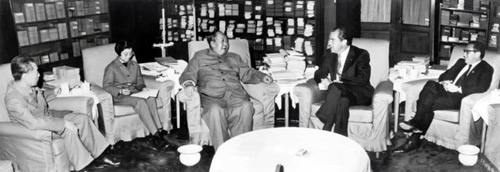 -
14
Chairman Mao Zedong (third left) meets with US President Richard Nixon (forth left) in Zhongnanhai, the central headquarters for the Chinese government and Communist Party of China, in 1972. Accompanying them were Chinese Premier Zhou Enlai (first left) and US Secretary of State Henry Kissinger (first right).
-
US President Nixon's visit to China and establishment of the Sino-US diplomatic ties
US President Richard Nixon's official visit to China spanned from February 21 to 28, 1972. On February 28, the two countries issued the Sino-US Joint Communiqué, which opened up the door of friendly exchanges between the two countries.
The Sino-US Joint Communiqué was a document guiding the bilateral relations between the two countries, and its issuance signaled the end of isolation between the two countries and the beginning of normalized Sino-US relations.
On December 16, 1978, China and the US issued the Joint Communiqué on the Establishment of Diplomatic Relations between the People's Republic of China and the United States of America, followed by China and the US agreeing to recognize each other and establish diplomatic relations on January 1, 1979. This communiqué reaffirmed the principles agreed upon by the two sides in 1972, resulting in both countries deciding to exchange ambassadors and establish embassies on March 1, 1979.
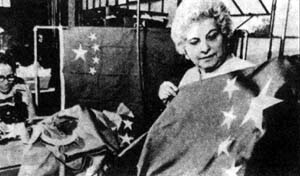 -
15
Workers in America sewing Chinese flags used by the United Nations. The passage of Resolution 2758 at the 26th Session of the United Nations General Assembly on October 25, 1971 restored the People’s Republic of China's lawful rights to the UN.
-
China's resumption of legal seating in the United Nations (UN)
On October 25, 1971, the 26th United Nations General Assembly passed Resolution 2758 with an overwhelming majority of votes and restored all the lawful rights of the People's Republic of China in the UN and expelled the representatives of the Taiwan authorities from the United Nations and all its affiliated agencies.
China had established diplomatic relations with only 64 nations prior to October 24, 1971, but after the passage of UN Resolution 2758, China's diplomatic stage soon extended far and wide globally. Currently, the number of nations that have diplomatic ties with China has reached 169, with more than 100 of them having established their diplomatic relations after China's reinstatement into the UN.
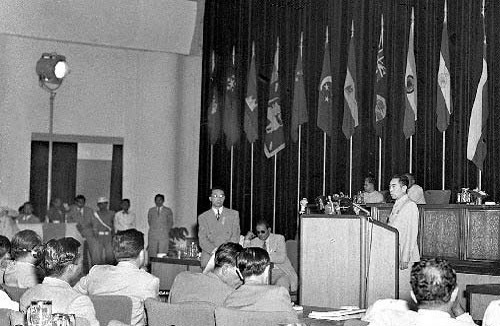 -
16
Chinese Premier Zhou Enlai delivers a speech at the closing ceremony of the Bandung Conference, hosted by Indonesia on April 18-24, 1955. Participants at the conference included delegates from 29 countries and regions in Asia and Africa. For the first time in history, no colonial powers attended, allowing the discussions to revolve around the interests of the two continents. The 10-point principle guiding international relations stated in the Final Communiqué of the conference incorporated the spirits of the Five Principles of Peaceful Coexistence raised by Zhou a year ago.
-
Bandung Conference
In 1955, a Chinese delegation attended the Bandung Conference, which was the first international conference not attended by any colonial powers. It was there that Zhou Enlai proposed the guidelines of "seeking common ground while shelving differences".
The conference unanimously passed the Final Communiqué of the Bandung Conference, which covered the following points: economic cooperation, cultural cooperation, human rights, self-determination, problems of dependent-territories' peoples, and a declaration on the promotion of world peace and cooperation.
The communiqué established a set of 10-point principles guiding international relations, serving as an extension and further development of the Five Principles of Peaceful Coexistence.
The conference also called on Asian and African nations to exhibit the Bandung Spirit, which implored them to unite together, strive for peaceful coexistence and friendly cooperation, and wage concerted struggles in opposition to imperialism and colonialism.
|
 |











